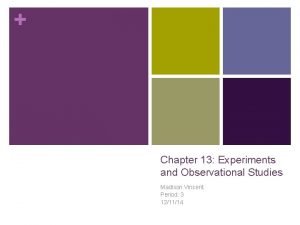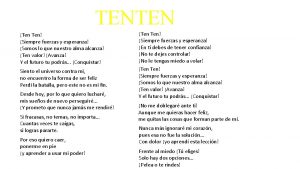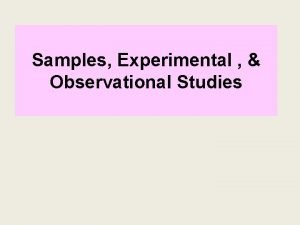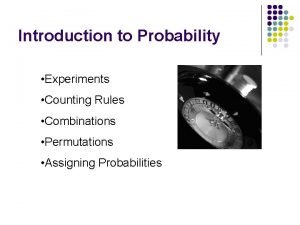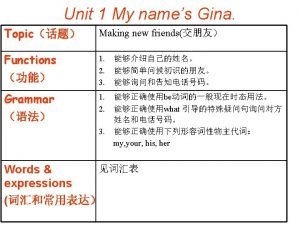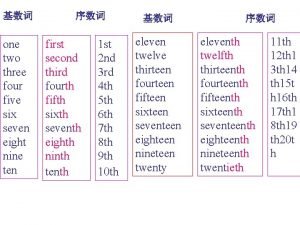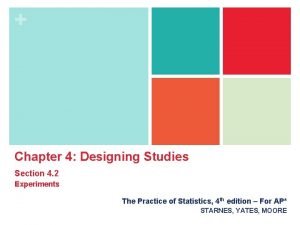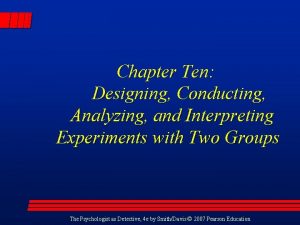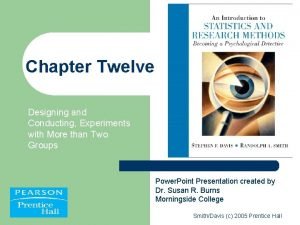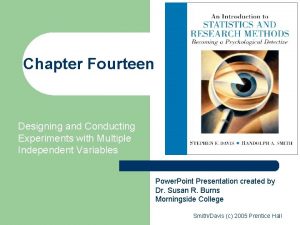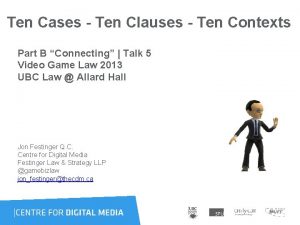Chapter Ten Designing and Conducting Experiments with Two



























- Slides: 27

Chapter Ten Designing and Conducting, Experiments with Two Groups Power. Point Presentation created by Dr. Susan R. Burns Morningside College Smith/Davis (c) 2005 Prentice Hall

Experimental Design: The Basic Building Blocks l Experimental design – The general plan for selecting participants, assigning participants to experimental conditions, controlling extraneous variables, and gathering data. Smith/Davis (c) 2005 Prentice Hall

The Two-Group Design l Principle of parsimony (Ockam’s razor) – The belief that explanations of phenomena and events should remain simple until the simple explanations are no longer valid. Smith/Davis (c) 2005 Prentice Hall

The Two-Group Design l Independent variable (IV) – A stimulus or aspect of the environment that the experimenter directly manipulated to determine its influences on behavior. l l l Chapters 10 and 12 deal with research designs that have one IV. Chapter 14 deals with research designs that have more than one IV. Dependent variable (DV) – A response or behavior that is measured. It is desired that changes in the DV be directly related to manipulation of the IV. Smith/Davis (c) 2005 Prentice Hall

The Two-Group Design Smith/Davis (c) 2005 Prentice Hall

The Two-Group Design l How many groups? – Although an experiment can have only one IV, it must have at least two groups. l l The simplest way to find out whether our IV caused a change in behavior is to compare some research participants who have received our IV to some others who have not received the IV. If those two groups differ, and we are assured that we controlled potential extraneous variables, then we conclude that the IV caused the participants to differ. Smith/Davis (c) 2005 Prentice Hall

The Two-Group Design l Extraneous variables – Undesired variables that may operate to influence the DV and, thus, invalidate an experiment. Smith/Davis (c) 2005 Prentice Hall

The Two-Group Design l Levels – – The most common manner of creating two groups with one IV is to present some amount or type of IV to one group and to withhold that IV from the second group. Thus, the presence of the IV is contrasted with the absence of the IV. These differing levels of the IV are referred to as the levels (also known as treatment conditions) of the IV. Differing amounts or types of an IV used in an experiment (also known as treatment conditions). Smith/Davis (c) 2005 Prentice Hall

The Two-Group Design l Experimental group – l In a two-group design, the group of participants that receives the IV. Control group – In a two-group design, the group of participants that does not receive the IV. Smith/Davis (c) 2005 Prentice Hall

The Two-Group Design l Assigning Participants to Groups – Random Assignment l l A method of assigning research participants to groups so that each participant has an equal chance of being in any group. Random assignment is not the same as random selection. When we randomly assign participants to groups, we have created what are known as independent groups. When we wish to compare the performance of participants in these two groups, we are making what is known as a between -subjects comparison. Smith/Davis (c) 2005 Prentice Hall

The Two-Group Design l Independent groups – l The participants in one group have absolutely no ties or links to the participants in the other group. Between-subjects comparison – Refers to a contrast between groups of participants who were randomly assigned to groups. Smith/Davis (c) 2005 Prentice Hall

The Two-Group Design l Confounded experiment – – – An experiment in which an extraneous variable varies systematically with the IV. Confounding makes drawing a cause-and-effect relation impossible. Confounding may occur if participants are not equal before the start of the experiment. Smith/Davis (c) 2005 Prentice Hall

The Two-Group Design l Nonrandom Assignment to Groups. – – – Random assignment tends to create equal groups in the long run. As groups get larger, we can place more confidence in random assignment achieving what we want it to. If we are faced with a situation in which we have few potential research participants and we are worried that random assignment may not create equal groups. What can we do? Smith/Davis (c) 2005 Prentice Hall

The Two-Group Design l Correlated assignment – – A method of assigning research participants to groups so that there is a relationship between small numbers of participants. These small groups are than randomly assigned to treatment conditions (also known as paired or matched assignment). Smith/Davis (c) 2005 Prentice Hall

The Two-Group Design l Correlated assignment – Matched pairs l Research participants in a two-group design who are measured and equated on some variable before the experiment. Typically we measure a variable that could result in confounding if not controlled. – After we have measured this variable, we create pairs of participants that are equal on this variable. – After we have created our matched pairs, we then randomly assign participants from these pairs to the different treatment conditions. – Smith/Davis (c) 2005 Prentice Hall

Psychological Detective l In what way is matched assignment guaranteed to create equal groups when random assignment is not? Smith/Davis (c) 2005 Prentice Hall

The Two-Group Design l Correlated assignment – Repeated measures l l The same participants are tested in both treatment conditions of our experiment. The matched pairs are perfectly equal because they consist of the same people or animals tested across the entire experiment. No extraneous variables should be able to confound this situation because any difference between the participants’ performance in the two treatment conditions is due to the IV. In this type of experiment, participants serve as their own controls. Smith/Davis (c) 2005 Prentice Hall

Psychological Detective l Why is it not possible to use repeated measures in all experiments? Think of two reasons. Smith/Davis (c) 2005 Prentice Hall

The Two-Group Design l Correlated assignment – Natural pairs l Pairs of participants are created from naturally occurring pairs (e. g. biologically or socially related). – For example, psychologists who study intelligence often use twins as their research participants. Smith/Davis (c) 2005 Prentice Hall

The Two-Group Design l Within-subjects comparison – Refers to a contrast between groups of participants who were assigned to groups through matched pairs, natural pairs, or repeated measures. l l We are essentially comparing scores within the same participants (subjects). Although this direct comparison is literally true only for repeated-measures designs, participants in matched or natural pairs are the same with regard to the matching variable. Smith/Davis (c) 2005 Prentice Hall

Comparing Two-Group Designs l Choosing a two-group design – Random assignment should equate your groups adequately (assuming that you have large groups). l l If you are using 20 or more participants per group, you can feel fairly safe that randomization will create equal groups. If you are using 5 or fewer participants in a group, randomization may not work. Smith/Davis (c) 2005 Prentice Hall

Comparing Two-Group Designs l Advantages of correlated groups designs – Control issues l – The three methods for creating correlated-groups designs give us greater certainty of group equality. Statistical issues l Correlated-groups designs can help reduce error variation. Smith/Davis (c) 2005 Prentice Hall

Comparing Two-Group Designs l Error variability – – – Variability in DV scores that is due to factors other than the IV – individual differences, measurement error, and extraneous variation (also known as within-groups variability). It is important to reduce error variability because all statistical tests reduce to the following formula: The possibility of a result occurring by change goes down as the value of your statistic increases. Your knowledge of math tells you that there are two ways to increase the value of your statistic: increase the between-groups variability or decrease the error variability. Smith/Davis (c) 2005 Prentice Hall

Psychological Detective l Can you figure out why using a correlatedgroups design can help reduce error variability? Smith/Davis (c) 2005 Prentice Hall

Comparing Two-Group Designs l Advantages of independent-groups designs – – Simplicity Use of correlated-groups designs is impossible in some situations. Smith/Davis (c) 2005 Prentice Hall

Variations on the Two-Group Designs l Comparing Different Amounts of an IV – – l The most common use of the two-group design is to compare a group of participants receiving the IV (experimental group) to a group that does not receive the IV (control group). This approach is known as the presence-absence IV manipulation. Some IVs simply cannot be contrasted through presence-absence manipulations. The key point is to notice when conducting an experiment contrasting different amounts of an IV, you no longer have a true control group Smith/Davis (c) 2005 Prentice Hall

Dealing with Measured IVs l True experiment – l An experiment in which the experimenter directly manipulates the IV. Ex post facto research – – A research approach in which the experimenter cannot directly manipulate the IV but can only classify, categorize, or measure the IV because it is predetermined in the participants (e. g. IV = sex). The drawback of ex post facto research is that we are not able to draw a cause-and-effect conclusion and thus are somewhat limited. Smith/Davis (c) 2005 Prentice Hall
 What are surveys experiments or observation
What are surveys experiments or observation Chapter 13 experiments and observational studies
Chapter 13 experiments and observational studies Ten-twenty-thirty
Ten-twenty-thirty Ten ten siempre fuerzas y esperanza
Ten ten siempre fuerzas y esperanza Am i a 10/10
Am i a 10/10 Electrostatic forces meaning
Electrostatic forces meaning Two parallel conducting plates
Two parallel conducting plates American experiments chapter 2
American experiments chapter 2 Chapter 29 conducting marketing research answers
Chapter 29 conducting marketing research answers Chapter 29 conducting marketing research
Chapter 29 conducting marketing research The marketing research process follows five steps
The marketing research process follows five steps Xerox lakes project is an example of
Xerox lakes project is an example of How to designing and managing service processes
How to designing and managing service processes Designing and managing services kotler keller ppt
Designing and managing services kotler keller ppt Observational survey examples
Observational survey examples 2k factorial experiments and fractions
2k factorial experiments and fractions Miller and urey's experiments attempted to demonstrate
Miller and urey's experiments attempted to demonstrate Counting rule for combinations
Counting rule for combinations Animal testing pros and cons
Animal testing pros and cons Nn torrent
Nn torrent Five six seven eight
Five six seven eight Zero one two three
Zero one two three Five six seven
Five six seven Twenty five past eleven
Twenty five past eleven Chapter 7 designing organizational structure
Chapter 7 designing organizational structure Chapter 7 designing organizational structure
Chapter 7 designing organizational structure Matched pair design
Matched pair design Channel design decisions with examples
Channel design decisions with examples

